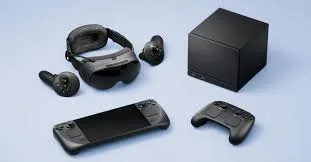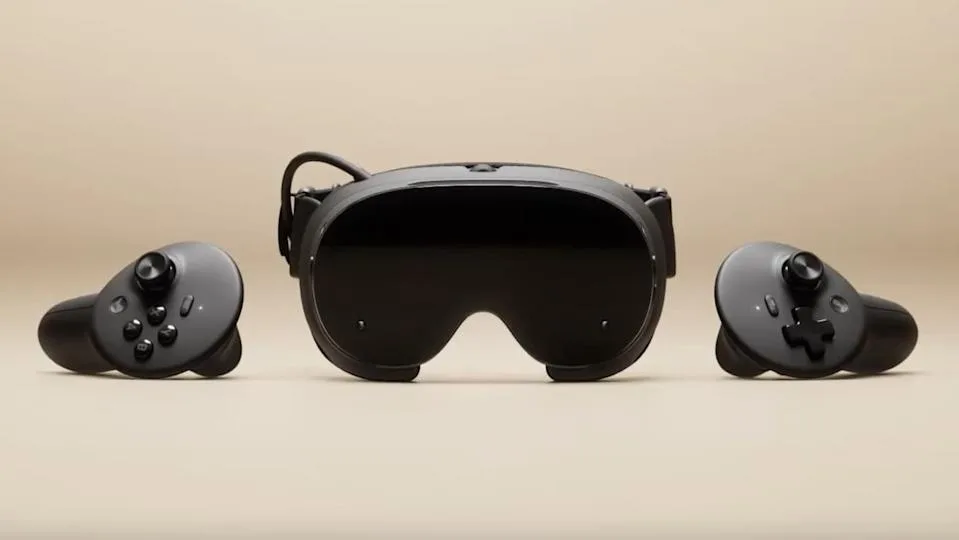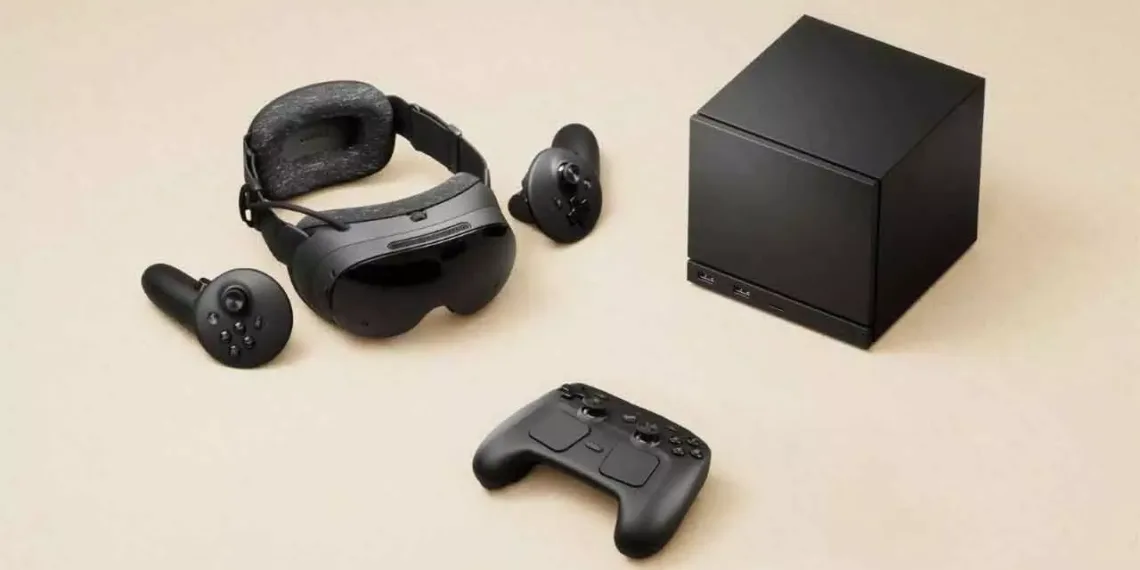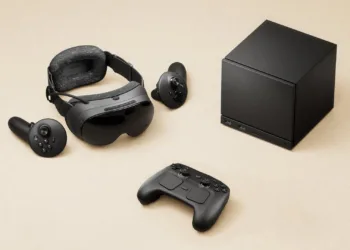Gaming giant Valve has stunned the industry with a triple hardware announcement that fundamentally reshapes PC gaming’s future. The Steam Frame VR headset, Steam Machine console, and redesigned Steam Controller will all launch in early 2026, marking Valve’s most ambitious hardware expansion since the Steam Deck revolutionized handheld gaming. These interconnected devices create an ecosystem allowing gamers to access their Steam libraries anywhere—from immersive VR experiences to living room console gaming and traditional desktop setups.
Table of Contents
Valve Steam Frame: Wireless VR Without Compromises
The Steam Frame represents a “streaming-first” standalone VR headset that fundamentally shifts how Valve approaches virtual reality. Unlike the tethered Valve Index from 2019, this completely wireless headset runs SteamOS natively on a Snapdragon 8 Gen 3 processor with 16GB RAM, eliminating PC dependency for standalone gaming.

The headset weighs just 435 grams and includes a plug-and-play 6GHz wireless adapter with dual-radio setup—one dedicated to streaming audio and visuals, the other for Wi-Fi connectivity. This engineering approach minimizes interference during wireless streaming from gaming PCs or the Steam Machine.
The device uses foveated streaming with eye tracking that optimizes detail where players are looking, delivering what Valve claims is over 10x improvement in image quality and effective bandwidth. Four grayscale tracking cameras provide inside-out tracking for both headset and controllers, with two cameras enabling monochrome passthrough functionality.
Steam Frame Technical Specifications
| Component | Specification |
|---|---|
| Processor | Snapdragon 8 Gen 3 |
| RAM | 16GB LPDDR5 |
| Storage | 256GB / 1TB (expandable via microSD) |
| Display | 2160 x 2160 LCD per eye |
| Refresh Rate | 72-144Hz variable |
| Field of View | 110 degrees |
| Weight | 435 grams (0.9 lbs with headstrap) |
| Battery | 21.6 Wh replaceable rear battery strap |
| Tracking | Inside-out camera-based, 4 cameras |
| Connectivity | Wi-Fi 7, 6GHz wireless adapter included |
| Controllers | Steam Frame Controllers (6-DOF tracking) |
| Special Features | Eye tracking, monochrome passthrough |
The included Steam Frame Controllers feature split gamepad format with D-pad, thumbsticks, ABXY buttons, triggers, and bumpers—designed to work seamlessly with both VR and flatscreen games from your entire Steam library. Each controller runs approximately 40 hours on AA batteries, while magnetic thumbsticks support capacitive finger tracking.
Steam Machine: Six Times More Powerful Than Steam Deck
The Steam Machine boasts a semi-custom AMD Zen 4 6-core/12-thread processor running up to 4.8 GHz paired with semi-custom AMD RDNA3 28 compute units, making it six times more powerful than Steam Deck. This compact six-inch cube brings desktop-class PC gaming to living rooms with full SteamOS integration.
The RAM and storage are user-upgradable, though CPU and GPU are soldered on. Available in 512GB and 2TB configurations, the system features four USB-A ports, DisplayPort, HDMI, Ethernet, USB-C, and microSD card slot. It supports Wi-Fi 6E, Bluetooth 5.3, HDMI 2.0, and DisplayPort 1.4.
The Steam Machine serves dual purposes: delivering 4K gaming at 60 FPS on televisions and streaming games wirelessly to Steam Deck, Steam Frame, or any device running Steam Link. Valve will introduce a Steam Machine Verified program similar to Steam Deck’s compatibility ratings, letting users see at a glance how well games perform on the hardware.
Steam Machine Key Features
| Feature | Details |
|---|---|
| CPU | Semi-custom AMD Zen 4 (6C/12T, up to 4.8 GHz) |
| GPU | Semi-custom AMD RDNA3 (28 CUs, 8GB GDDR6 VRAM) |
| RAM | 16GB DDR5 (user-upgradable) |
| Storage | 512GB / 2TB (user-upgradable) |
| Size | Approximately 6-inch cube |
| Operating System | SteamOS |
| Connectivity | 4x USB-A, DisplayPort, HDMI, Ethernet, USB-C |
| Wireless | Wi-Fi 6E, Bluetooth 5.3 |
| Power | Built-in PSU (AC cable only) |
| Performance | 6x Steam Deck power, targets 4K/60 FPS |
New Steam Controller: The Best of Both Worlds
Valve’s second-generation Steam Controller abandons the experimental touchpad-only design from 2015 for a hybrid approach combining traditional gamepad controls with PC-centric features. The controller features dual analog sticks positioned PlayStation-style, D-pad, ABXY buttons, triggers, bumpers, and four back buttons.
Two large trackpads allow players to control mouse cursors in PC games utilizing mouse controls, bridging the gap between controller and keyboard-mouse gaming. High-definition rumble, magnetic thumbsticks with capacitive finger tracking, and grip-enabled gyro controls provide precision input customizable through Steam Input software.

The controller works seamlessly across Valve’s entire hardware ecosystem—Steam Deck, Steam Machine, Steam Frame, and any PC—with approximately 35 hours of battery life per charge. A magnetic connector on the rear suggests potential accessory support.
Release Timeline and Availability
All three devices launch in early 2026 across the same regions where Steam Deck currently ships. Valve hasn’t announced specific pricing or exact release dates, though developers can apply for limited early access Steam Frame development kits immediately.
The Steam Frame fully replaces the Valve Index in Valve’s lineup, which the company confirmed is no longer in production. This strategic shift signals Valve’s commitment to wireless, standalone VR experiences over tethered PC-exclusive solutions.
Industry observers anticipate the Steam Machine will price competitively with mid-range gaming PCs—potentially $500-600 for base configurations—positioning it as an accessible entry point for Steam’s living room gaming vision. The Steam Frame likely targets pricing between Meta Quest 3 and premium PC VR headsets, though official confirmation awaits.
Building a Complete Steam Ecosystem
These products work harmoniously rather than competing. The Steam Machine serves as both standalone living room console and streaming powerhouse for Steam Frame and Steam Deck. The Steam Controller provides consistent input across all devices. The Steam Frame delivers portable VR experiences while maintaining access to your complete Steam library through wireless streaming.
For gamers invested in Steam’s ecosystem, this represents unprecedented flexibility. Play demanding AAA titles on your TV through Steam Machine, switch to VR with Steam Frame, or take gaming portable with Steam Deck—all using the same library, saves, and controller.
For comprehensive VR buying guidance, explore our complete VR headset comparison guide and discover PC gaming setup optimization tips.
Frequently Asked Questions
Q: Can the Steam Frame run VR games without a gaming PC?
Yes, the Steam Frame operates as a standalone VR headset powered by the Snapdragon 8 Gen 3 processor with 16GB RAM. It runs SteamOS natively and can play less demanding VR titles, flatscreen games, and Android apps independently. However, Valve positions it as “streaming-first” because graphically intensive VR games perform best when wirelessly streamed from a gaming PC or Steam Machine using the included 6GHz wireless adapter. The Steam Frame Verified program will indicate which games run well standalone versus requiring streaming.
Q: How does the Steam Machine compare to building a custom gaming PC?
The Steam Machine offers convenience and compact design—a six-inch cube versus full tower cases—while running SteamOS for optimized Steam gaming experiences. With 6x Steam Deck performance targeting 4K/60 FPS, it handles modern AAA titles competently. However, custom PCs offer superior upgradeability (both CPU and GPU), potentially better raw performance at equivalent price points, and broader software compatibility including Windows-exclusive applications. The Steam Machine excels for users prioritizing living room gaming, space efficiency, and seamless integration with Steam’s hardware ecosystem over maximum performance or extensive customization options.








